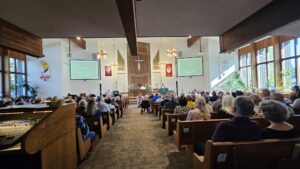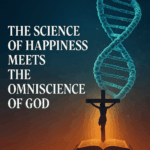“New Testament Giants of the Faith – Paul” – Acts 9:1-22
1. New Testament Giants of the Faith – Paul
As we move today to consider another New Testament Giant of the Faith, we are going to look at Saul, better known as Paul. (And Paul is what I’m going to call him throughout the sermon today, so that we don’t get confused with Saul/Paul terminology.) We heard about his conversion to that faith in our Acts 9 reading today. But let’s dig a little deeper into his background. Who was this guy?
We are actually introduced to Paul at the end of Acts 7 and in the first verse of Acts 8. In Acts 6, we hear about Stephen and six other men who are chosen to be servants in the early church, with special responsibility for social ministry for widows. Stephen also performed miracles and persuasively proclaimed the risen Jesus. He was arrested and questioned by the Jewish ruling group called the Sanhedrin. Stephen gave them a long history lesson – almost all of Acts 7 – which basically said they often persecuted God’s prophets, and now they have killed His Righteous One, Jesus. For that scathing accusation, they stoned Stephen to death. Paul was reported to be the “coat check” guy at Stephen’s stoning, and he gave approval to his death.
In Acts 9, we read about him threatening and arresting the followers of Jesus, not just in Jerusalem but all the way to Damascus. To the early church, Paul was one of the bad guys! But to the Jews, Paul was one of the good guys – squashing this break-away religious group with its new and unacceptable ideas. Paul would later state how he could have boasted of his Jewish heritage and his reasons for confidence in the flesh: in 2 Corinthians 11… a Hebrew, an Israelite, a descendant of Abraham; and in Philippians 3… circumcised on the 8th day, of the people of Israel, of the tribe of Benjamin, a Hebrew of Hebrews, a faultlessly righteous Pharisee who persecuted the church. That gives us a good sense of who Paul was as Acts 9 introduces him to us more fully.
2. Astonishing conversion
Acts 9 tells us the story of who Paul becomes. He was one of the bad guys in the eyes of the early church, but he becomes one of the good guys, one of the GREAT guys. We heard the story:
– he was going to Damascus to arrest those who belonged to the Way (the followers of Jesus).
– he was blinded by a light from heaven.
– he encountered Jesus, the one who he was persecuting, the one whose followers he was persecuting.
– Acts 9 records only a brief dialog, but there must have been more that Jesus said to Paul.
– Paul goes into Damascus, blind for three days.
– God tells Ananias, a disciple of Jesus, to go and heal Paul, and baptize him, for he would be God’s much-suffering missionary to the Gentiles.
– Paul is healed and is baptized and immediately begins to powerfully proclaim and prove that Jesus is the Christ.
In my “Weekly Encouragement” message on Wednesday, I made reference to those Magic Eye posters that are either annoying or amazing. Here’s one on the screen. If you stare at it long enough, if you look at it a little cross-eyed, if you look through the picture instead of at it, if you look at it at the correct angle, a 3-dimensional image will pop out at you from the piece of paper, or maybe even the screen. When you see it, it’s an “Aha!” moment, and you are amazed that there can be something recognizable in the gobbledygook of images. If you don’t see it, you are just annoyed and maybe unbelieving that there is actually an image there. So, on the image on the screen there are two words… if you can see them, say them with me on the count of 3… 1, 2, 3… Carpe Diem (Seize the Day).
That’s what happened to Paul on the road to Damascus. He had the “Aha!” moment of all “Aha!” moments. He saw Jesus! He encountered Jesus! He met the risen Jesus! And he seized the day, or perhaps more properly the day, and the Lord seized him. And that Lord transformed his life from two-dimensional to three-dimensional. That Jesus changed him from a persecutor of Jesus to a proclaimer of Jesus. It was an astonishing, an amazing conversion. If John Newton had written “Amazing Grace” by that time, Paul would have been singing it: “Amazing Grace how sweet the sound that saved a wretch like me. I once was lost but now am found, was blind but now I see.” He was a wretch, a hater, a sinner, then blinded… but Jesus not only restored his physical sight, He also gave him spiritual sight.
3. Most persuasive missionary
Now let’s go deeper into the story of Paul in the book of Acts. We heard that, after his conversion, he spent some time with the disciples in Damascus. He needed to learn more about Jesus, but it didn’t take long for him to use his existing knowledge of God and Scripture to point out how Jesus fulfilled everything that God had promised about the Saviour in the Old Testament. Then Paul spent some time under the instruction of Barnabas, a spiritually mature follower of Jesus. After a brief interlude with some stories about Peter – and we’ll pick up his story in two weeks – the rest of the book of Acts is about Paul and his travels as the most persuasive missionary for Jesus in the first century and in the area around the northeast Mediterranean.
Paul and Barnabas were commissioned as missionaries by the church in Antioch, and they were sent out to bring the name of Jesus first to Jews and then also to Gentiles. They did that by going first to the Island of Cyprus, and then in a town-by-town journey into present-day Turkey, before returning to Antioch where they had started. Their approach was consistent in each place. They would go first to the synagogue to talk to Jews who were familiar with God and the Scriptures. If and when they were rejected, they would take the message of Jesus to Gentile people.
After a church convention in Jerusalem and a disagreement with Barnabas, Paul took a new missionary partner, Silas, on his second journey. This time, they were compelled to travel to a handful of towns in Macedonia, Northern Greece and from there into Greece proper, including the cosmopolitan Roman cities of Athens and Corinth. In Philippi, Paul and Silas were thrown into prison, but their testimony about Jesus led the jailer and his family to both faith and Baptism. After a couple of other stops, Paul ended up in Athens where he noticed all the altars and statues, including one erected “To An Unknown God.” Paul took the opportunity to tell those gathered about the God who made heaven and earth and whose Son rose from the dead. After a lengthy stay in Corinth, Paul returned again to Antioch.
A third missionary journey took Paul to many of the same towns that he had visited previously in both Turkey and Greece. This time he went back all the way to Jerusalem. His proclamation had mixed results – some Jews believing and following Jesus, others rejecting Paul’s teaching about Jesus and resurrection; some Gentiles believing and following Jesus, others rejecting. But virtually everywhere he went, he left pockets of believers who were passionate to follow Jesus. As he did all that, Paul was completing the fourth geographic aspect of Jesus’ Great Commission – being Jesus’ witnesses in Jerusalem, Judea, Samaria and… now, with Paul, to the ends of the earth.
Back in Jerusalem, Paul ran into trouble with his old buddies, the Jews. They were aware that what he was saying was not only for Jesus, but also against them. He got arrested, faced several trials under various political leaders, and, because he was born a Roman citizen, he appealed his arrest and potential punishment all the way to Caesar. This took him on a fourth journey, which included a shipwreck during a fierce storm on the Mediterranean Sea, but saw him end up imprisoned in Rome, and we don’t know for sure what happened after that.
4. Prolific New Testament writer
One thing we do know is that Paul’s ministry and his missionary heart wasn’t shut down just because he was in jail. We don’t hear more about his travels and his preaching to Jews and Gentiles alike, but we do know that he spent time in jail writing. In the New Testament, we have 13 letters that Paul wrote to individuals and to church groups to encourage and correct and teach them in their new-found Christian faith. There are hints that Paul wrote even more letters, ones that somehow got lost in history. But the ones we do have are treasures that deepen our faith in and our understanding of Jesus and how God has extended His forgiveness and love, His grace and salvation to us by Jesus’ death and resurrection. As both a great missionary and a prolific and Holy Spirit inspired writer, it’s easy to put Paul into the category of a New Testament Giant of the Faith.
Let’s consider the content of a couple of Paul’s letters:
Paul had not yet visited the Christian community in Rome, so his letter to the Romans sets out a master theological treatise and a clear systematic declaration of the Gospel. Paul begins by surveying the spiritual landscape of all humanity and he finds that both Jews and Gentiles are sinners, in fact, ALL are sinners in need of salvation. Because perfect obedience to the law is not possible, it provides no resolution to the problem of sin. However, God sent His Son Jesus to accomplish redemption and to provide forgiveness and righteousness by His death on the cross. Those gifts are received simply by faith in Christ, and people are thus freed from sin, the law, and death, with nothing to condemn us. The last few chapters of Romans outline how to live as followers of Jesus in the various spheres of our lives.
Here’s what Martin Luther had to say about the book of Romans:
“This epistle is really the chief part of the New Testament, and is truly the purest Gospel. It is worthy… that every Christian should know it word for word…
In it we thus find most abundantly the things that a Christian ought to know, namely, what is law, gospel, sin, punishment, grace, faith, righteousness, Christ, God, good works, love, hope and the cross; and also how we are to conduct ourselves toward everyone…”
Paul had visited and spent time in Corinth, proclaiming Jesus and supporting the growing community of believers there. Some five years later, he wrote back to them, and we could summarize Paul’s message to them in two words – “smarten up!” His purpose for writing was to correct some errors in Christian living that had crept into the church there, things like divisions, immorality, lawsuits among believers, and eating food sacrificed to idols. He also wanted to establish proper teaching on the Lord’s Supper and the resurrection of the dead, teachings which shape what we still know and believe on those two topics.
Besides the letters written to communities of believers, Paul also wrote a handful of letters to individuals. Timothy was like Paul’s apprentice pastor, left to shepherd the Christians in Ephesus. His first letter to Timothy – like all his letters – spoke boldly about Jesus who came into the world to save sinners. Paul warned Timothy about false teachers and the love of money, gave instructions about worship, and listed qualifications for leaders in the church. He also gave some personal instructions to his young assistant, and charged him to flee false doctrine and corrupt living, and instead to pursue righteousness, Godliness, faith, love, endurance and gentleness, guarding the very faith that had been entrusted to him.
5. Significant / memorable verses
I want to highlight for you one significant and memorable verse from each of Paul’s letters. In some cases, it’s hard to land on only one verse from an entire letter, so let me encourage you to crack open your Bibles this week, and find those other treasures that Paul wrote. Here we go…
Romans 8:1 – “There is now no condemnation for those who are in Christ Jesus.”
1 Corinthians 15:3-4 – “I passed on to you as of first importance: that Christ died for our sins according to the Scriptures… that He was raised on the third day according to the Scriptures…”
2 Corinthians 5:21 – “God made Him who had no sin to be sin for us, so that in Him we might become the righteousness of God.”
Galatians 3:27 – “All of you who were baptized into Christ have clothed yourselves with Christ.”
Ephesians 2:8 – “For it is by grace you have been saved, through faith – and this not from yourselves, it is the gift of God.”
Philippians 4:7 – “The peace of God, which transcends all understanding, will guard your hearts and your minds in Christ Jesus.”
Colossians 3:17 – “Whatever you do, whether in word or deed, do it all in the name of the Lord Jesus, giving thanks to God the Father through Him.”
1 Thessalonians 5:16-18 – “Be joyful always, pray continually, give thanks in all circumstances…”
2 Thessalonians 3:3 – “The Lord is faithful, and He will strengthen and protect you from the evil one.”
1 Timothy 2:5 – “There is one God and one mediator between God and men, the man Christ Jesus.”
2 Timothy 3:15 – “You have known the holy Scriptures which are able to make you wise for salvation through faith in Christ Jesus.”
Titus 3:5 – “He saved us through the washing of rebirth and renewal by the Holy Spirit.”
Philemon 5 – “I hear about your faith in the Lord Jesus, and your love for all the saints.”
There you go… a lot of theology, on a lot of different topics, all from Paul – a New Testament Giant of the Faith.
6. What we learn from Paul
And let me summarize a couple of things that we can learn from Paul’s life and from Paul’s writing.
From Paul’s own life story… no matter what your background has been, no matter what your past life has looked like, God has enough grace to rescue you and redeem you and call you into discipleship and service. God said to Paul, and He says to us, “My grace is sufficient for you.”
From Paul’s conversion experience and his subsequent proclamation of the faith that he was formerly persecuting, we want to know and believe that Jesus is the Christ, the promised one of God.
From Paul’s writings, we want to stand firm on what Paul said was of first importance, the main thing – that Christ died and rose… FOR YOU! And we want to keep the main thing the main thing.
From Paul’s writings we want to be confident that when we are “in Christ,” when we have faith in Christ, we are new creations and that just as Christ has been raised, so we can look forward joyfully to our own resurrection from the dead with a new and imperishable body, and so that when our loved ones die with faith in Christ we don’t grieve like those who have no hope in the resurrection.
From Paul’s writings we want to know that God is for us, and that nothing can separate us from His love in Christ Jesus. And that’s a great place to say… AMEN!!









